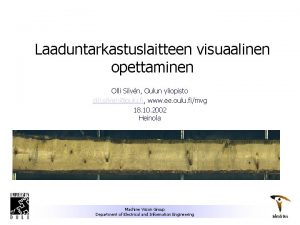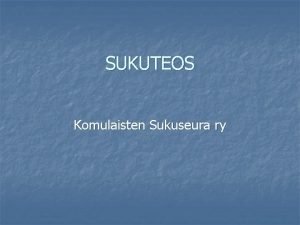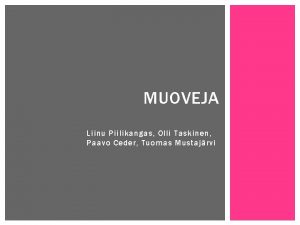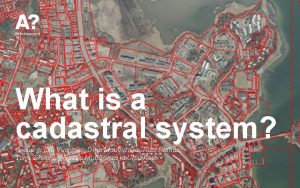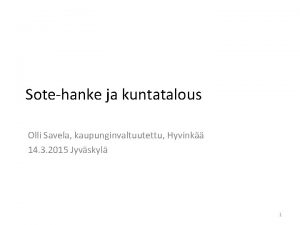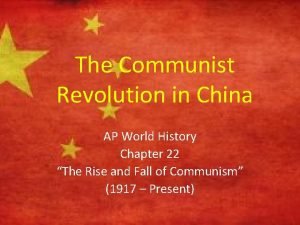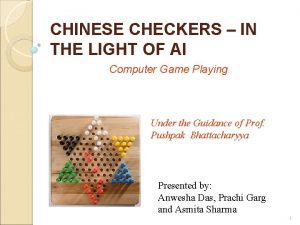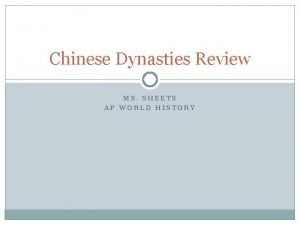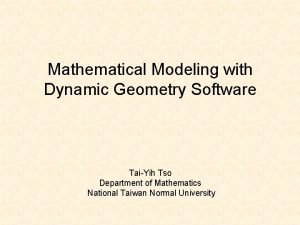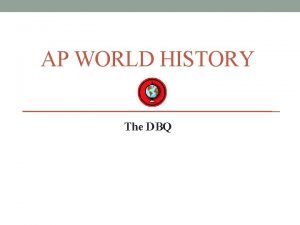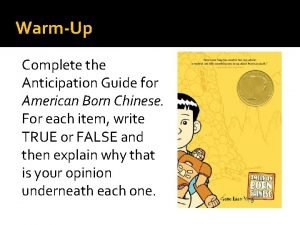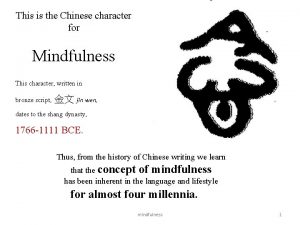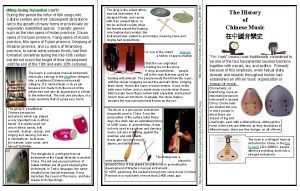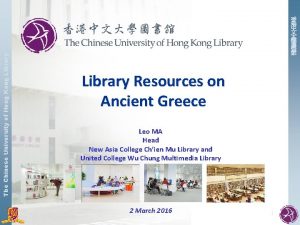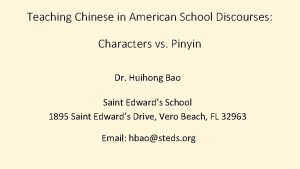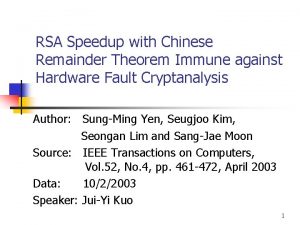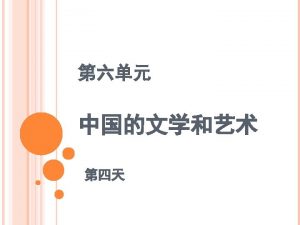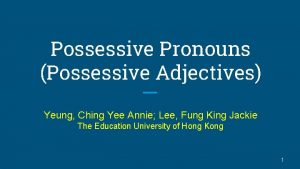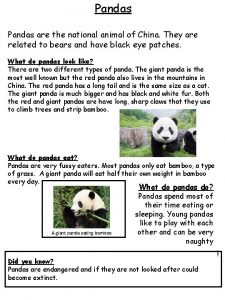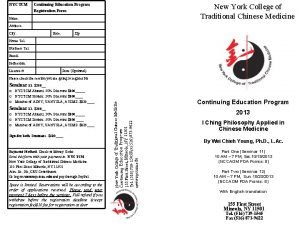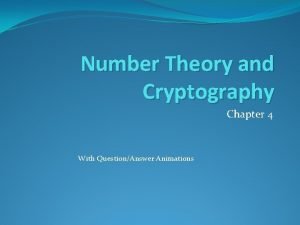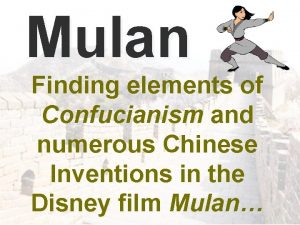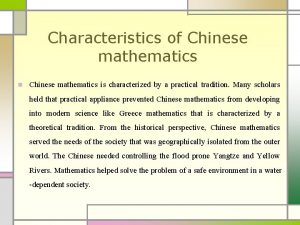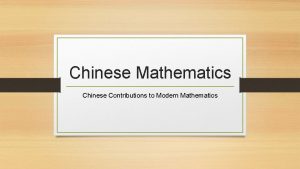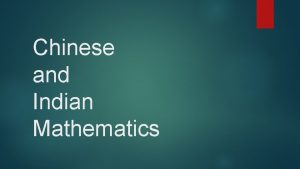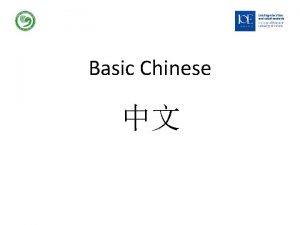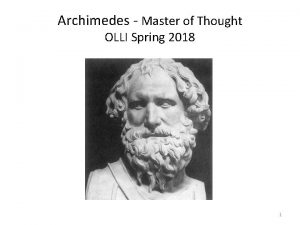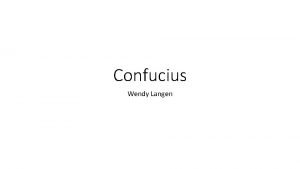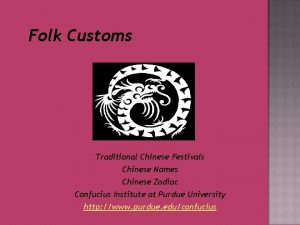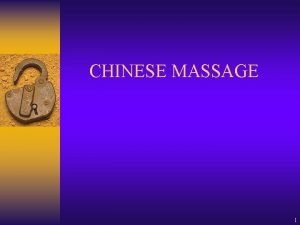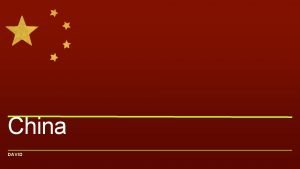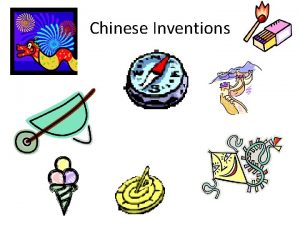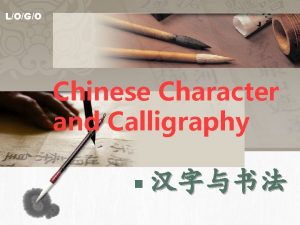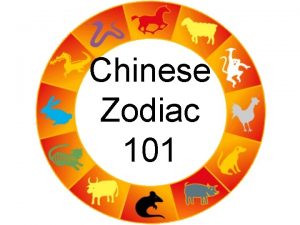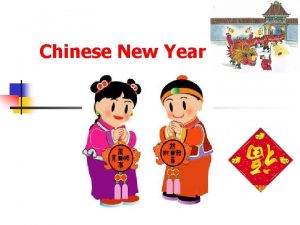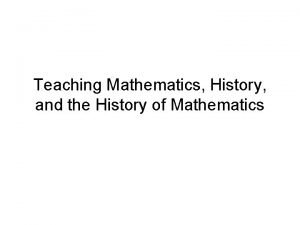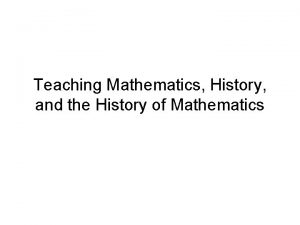History of Chinese Mathematics OLLI Spring 2018 1















































- Slides: 47

History of Chinese Mathematics OLLI Spring 2018 1

Earliest Record • Earliest record of mathematics is in the form of markings on tortoise undershells and bones – Late in the Shang dynasty (1700 – 1027 BCE) – Discovered in 1899 at Xiaotun (ruins of Yinxu) • Thousands of inscribed bones and tortoise undershells – ~ 5000 characters represented including earliest recorded numbers – Later finds added tens of thousands of characters – Numbers found range from 1 to 30000 with special characters for 10, 100, 1000, and 10000 • Documents from the Zhou period 1027 BCE – 221 BCE also reflect the decimal character of Chinese mathematics. Material from Joseph Dauben in reference 1 2

Numbers from 1899 Discovery • Numbers have multiplicative properties • 20, 30, & 40 are related to 2, 3 & 4 • 200 is 100 x 2 • 5000 is 1000 x 5 Tortoise shell writing 3

Number System • By Han dynasty (206 BCE – 220 CE) characters and notation for writing numbers had become well established and are essentially what is used today. Financial 零 壹 貳 (T) or � (S) � (T) or � (S) 肆 伍 陸 (T) or � (S) 柒 捌 玖 拾 佰 仟 萬 億 Normal 〇 一 Value 0 1 二 2 三 四 五 3 4 5 六 七 八 九 十 百 千 萬 (T) or 万 (S) 億 (T) or � (S) 6 7 8 9 10 10000 4321 3009 四千三百二十一 三千九 Note that a zero was not needed because of the way powers of 10 were integrated into the numbers. Fractions were written with the denominator given first followed by the phrase “parts of” and then the numerator. ¾ 四 分之三 1 E+08 4

Rod Numbers • Dating from between 4 th to 2 nd centuries BCE, the Chinese also used a positional number system based on symbols made up of horizontal and vertical bars. 1 2 3 4 5 6 7 8 9 • After a while it became clear that a number like 12 (| ||) could easily get confused with 3 (|||) so that they made a really neat change to their symbols. They continued to use the above symbols for the 1, 10000, etc places. For the 10, 100000, etc they used: 10 20 30 40 50 60 70 80 90 5

More Rod Numbers (84, 902) O 8 4 9 0 2 In about the 8 th century CE an “O” was introduced probably through the influence of the Hindu number system. When the rod numbers were used in manuscripts or printed documents the numbers were used as a single symbol with the horizontal and vertical strokes joined together 6

The Counting Board Step 1 Addition Problem 273 1758 1 Step 2 Step 3 273 1758 19 202 Step 4 273 1758 2031 7

Burning of books and burying of scholars • (traditional Chinese: 焚書坑儒; simplified Chinese: 焚�坑儒; pinyin: fénshū kēngrú; literally "burning of books and burying (alive) of (Confucian) scholars") is the historically significant burning of writings and slaughter of scholars. These events began around the Qin Dynasty of Ancient China; between the period of 213 and 210 BC. • "Books" at this point referred to writings on bamboo strips which were then bound together. This contributed to the loss to history of many philosophical theories of proper government (known as "the Hundred Schools of Thought"). The official philosophy of government ("legalism") survived. 8

Early Texts • Burning of books and burying of scholars – between the period of 213 and 210 BC. • Suan shu – A Book on Numbers and Computation (180 BCE) – – – Earliest known extensive Chinese writing on mathematics Originally called a Book of Arithmetic Discovered in 1983 – 1984 in Hubei province Constructed of ~ 200 bamboo strips Author unknown although some names appear in various sections • A translation of Suan shu with comments by Christopher Cullen can be found at http: //www. nri. org. uk/suanshushu. html 9

Early Texts continued • Zhou bi suan jing – Mathematical Classic of the Zhou Gnomon – Compiled between 100 BCE and 100 CE – Astronomy text showing how to measure the position of the heavenly bodies – Contains important sections on mathematics • Includes the Pythagorean Theorem • Jiu zhang suan shu – The Nine Chapters on the Mathematical Art – Believed composed and commented on over many centuries originating possibly as early as 1000 BCE. – Liu Hui – the Chinese Euclid (~220 CE - ~ 280 CE) • Liu Hui’s edition with commentaries formed the basis for the text which was central to Chinese Mathematics • Also wrote the Sea Island Mathematical Classic which introduced the double difference method for surveying 10

The Ten Mathematical Classics Edited by Li Chunfeng (602 – 670 CE) • Zhou bi suan jing – Mathematical Classic of the Zhou Gnomon • • • 100 BCE – 100 CE Jiuzhang suanshu (Nine Chapters on the Mathematical Art) 263 CE Haidao suanjing (Sea Island Mathematical Manual) 263 CE Sunzi suanjing (Sun Zi's Mathematical Manual) early 5 th century CE ? Wucao suanjing (Mathematical Manual of the Five Administrative Departments) 5 th century CE Xiahou Yang suanjing (Xiahou Yang's Mathematical Manual) Zhang Qiujian suanjing (Zhang Qiujian's Mathematical Manual) Wujing suanshu (Arithmetic methods in the Five Classics) Jigu suanjing (Continuation of Ancient Mathematics) Shushu jiyi (Notes on Traditions of Arithmetic Methods) Zhui shu (Method of Interpolation) Sandeng shu (Art of the Three Degrees; Notation of Large Numbers) The Mac. Tutor History of Mathematics archive http: //www-history. mcs. st-and. ac. uk/ 11

Cullen’s Suan shu (180 BCE) TOC Introduction 1 • Group 7: Wastage, and equivalents 65 – Bibliography 16 • Group 8: Allowing for mistakes 69 • Translation 21 • Group 9: Converting grains 70 • Group 1: Elementary operations 35 • Group 10: Rationalising and checking tasks 77 • Group 2: Sharing; sharing in proportion; • Group 11: Excess and Deficit (‘Rule of False progressions 43 Position’) 81 • Group 3: Wastage 51 • Group 12: Shapes and volumes 89 • Group 4: Sharing, contributions and • Group 13: Circle and square 103 pricing 54 • Group 14: Sides and areas with • Group 5: Changes in rates 60 mixed numbers 105 • Group 6: Rating by unit 62 • Text of the Suàn shù shū 113 • 12

Suan Shu Content Summary • • • Group 1: Elementary operations - Multiplying fractions; simplifying fractions; adding fractions. Group 2: Sharing in proportion; progressions - Division of a mixed number by a whole number; subtraction of a fraction from a mixed number, and of one fraction from another; division of a common pool of profit or liability in ratio of contributions; the case of contributions in geometrical progression; restoration of an original amount repeatedly diminished in a given proportion to produce a given result; value of given amount of commodity given a unit price. Group 9: Converting grains - The use of standard ratios to calculate amount of one type of grain equivalent to another type, or amount of product when grain is processed; problems of sharing and mixing involving grains. 13

Suan Shu Content Summary • • • Group 10: Rationalizing and checking tasks - Calculation of a rate of unit production from rate at which parts of production task are completed; expected production of processed from raw silk; checking time taken for journey from cyclical days. Group 11: Rule of false position - Use of Rule of False Position to solve problems of sharing and mixtures, and extraction of approximate square root. Group 12: Shapes and volumes - Calculation of the volume of various 3 dimensional shapes. Group 13: Circle and square - Relative dimensions of a square and its inscribed circle. Group 14: Sides and areas with mixed numbers - Calculation of unknown side of rectangle, given area and one side; divisions involving the sum of several different unit fractions; multiplication of mixed numbers; interconversion of area units. 14

Group 10 S 132 • X travels for 50 days. Now today is [sexagenary day] renshen [the 9 th of the 60 -day cycle] Question: on what day did he begin his journey? Method: Enquire in what decade renshen [9] falls. Reply: It is the decade [commencing] jiazi [1] Given that starting at jia [1] and counting to ren [9] is nine days set out 9, and let it be increased. • Content: Although S 132 is undamaged, the text seems incomplete. A strip may be missing at this point. Once again the motivation of this problem seems to be the wish to maintain tight control of all state-managed activity. Here we have someone who arrives on day 9 of the sixty- day cycle designated by the systematic pairing of the two sets of ten and twelve cyclical characters, beginning with jiazi as the first pair. • If he claims to have been travelling for 50 days, on what day did he set out? Presumably the aim is to reconcile the present date and his authorized journey time with the day marked on his official ‘move order’. 15

Sample Problems • G 2 A fox, raccoon, and a hound go through customs, and (together) pay 111 qian. The hound says to the raccoon, and the raccoon says to the fox: since your fur is worth twice as much as mine, then the tax you should pay should be twice as much. The solution says: let each one double the other; adding them together (1 + 2 + 4), 7 is the divisor; taking the tax, multiplying by each (share) is the dividend; dividing the dividend by the divisor gives each ones share. Hound = 1 x 111/7 = 15 6/7; raccoon = 2 x 111/7 = 31 5/7; fox = 4 x 111/7 • G 4 100 qian are lent with interest for 30 days at 3 qian. If 60 qian are now lent and repaid in 16 days, how much is the interest? • G 10 One person in one day makes 30 arrows or feathers 20 arrows. If one now wishes to have one person both make arrows and feather them, in 1 day how many can be made? 16

Sample Problems Continued • G 11 Given a field of one mu. How many bu is it square? One mu = 240 bu squared. The problem is to find the square root of 240. If the side were 15 (s 1), then the square would have a deficit of 15 (d). If the side were 16 (s 2), the square would have an excess of 16 (e). The answer is (e*S 1 + d*S 2)/(d + e). The method works well for finding square roots if the two trial values are close enough to the solution so that a straight line is a good approximation to the second degree curve on which the solution lies. • G 12 Find the volume of a truncated pyramid. (correct solution) • G 12 Find the volume of a cone – solution implies p = 3 17

Zhou bi suan jing– Gou-gu Pythagorean Theorem 18

Liu Hui Little is know about Liu Hui except that he lived in the third century CE. He is often called the Chinese Euclid because he is responsible for the most important ancient Chinese mathematical text, the Nine Chapters on the Mathematical Art. 19

Liu Hui Comments Liu Hui wrote a commentary on the Nine Chapters on the Mathematical Art in 263 AD. He believed that the text which he was commentating on was originally written around 1000 BC but incorporated much material from later eras. He wrote in the Preface: In the past, the tyrant Qin burnt written documents, which led to the destruction of classical knowledge. Later, Zhang Cang, Marquis of Peiping and Geng Shouchang, Vice-President of the Ministry of Agriculture, both became famous through their talent for calculation. Because of the ancient texts had deteriorated, Zhang Cang and his team produced a new version removing the poor parts and filling in the missing parts. Thus, they revised some parts with the result that these were different from the old parts. . . Let us give some dates for the events Liu Hui describes. The Qin dynasty preceded the Han dynasty and it was the Qin ruler Shih Huang Ti who tried to reform education by destroying all earlier learning. He ordered all books to be burnt in 213 BC and Zhang Cang, who Liu Hui refers to, did his reconstruction around 170 BC. Most historians, however, would not believe that the original text of the Nine Chapters on the Mathematical Art was nearly as old as Liu Hui believed. In fact most historians think that the text originated around 200 BC after the burning of the books by Shih Huang Ti. Others give dates between 100 BC and 50 AD. 20

When was the Nine Chapters on the Mathematical Art written? What methods are used to try to date the material? Perhaps the most important is to examine the units of length, volume and weight which appear in the various problems. Standard decimal units of length were established in China around 200 BC and later further subdivisions occurred. That the basic units are used, but not the later subdivisions, leads to a date of shortly after 200 BC. In Liu Hui's commentary subdivisions introduced around 250 AD are used, which is in line with this commentary being written in 263 AD. 21

The Nine Chapters on the Mathematical Art • This book lays out an approach to mathematics that centers on finding the most general methods of solving problems, which may be contrasted with the approach common to ancient Greek mathematicians, who tended to deduce propositions from an initial set of axioms. • Entries in the book usually take the form of a statement of a problem, followed by the statement of the solution, and an explanation of the procedure that led to the solution. Ch. 1 Land Surveying (38) Ch. 2 Millet and Rice (46) Ch. 3 Proportional Distribution (20) Ch. 4 Short Width (24) Ch. 5 Civil Engineering (28) Ch. 6 Fair Taxation Plus (28) Ch. 7 Excess and Deficit (20) Ch. 8 Rectangular Arrays (18) Ch. 9 Right Angled Triangles (24) 22

Content of Nine Chapters • Liu Hui wrote a commentary on the Nine Chapters. Parts of the Nine Chapters may have been written as early as 1000 BCE. • Chapter 1 – Land Surveying – Area of triangles, rectangles, circles and trapezoids (Liu Hui calculated an accurate value of pi although 3 was used by most people)) – Addition, subtraction, multiplication, and division of fractions – Algorithm for finding the greatest common divisor of two numbers • Chapter 2 - Millet and Rice – The exchange of goods, particularly the exchange rates among 20 grains, beans, and seeds – Proportions and percentages • Chapter 3 – Proportional Distribution – Material similar to the fox, raccoon, and hound problem of the Suan Shu (the on the bamboo strips) 23

Ancient Chinese Units of Measurement 24

Chapter 1 Problem 32 • Given a circular field, the circumference is 181 bu and the diameter is 60 1/3 bu. What is the area? Answer 11 mu 90 1/12 [square] bu • Observations 1: C = 3 D and p = 3 • Observation 2: Area = CD/4 • Liu Hui comments extensively on this problem: – He notes that the perimeter of an inscribed hexagon is 3 times the diameter of the circle and surely the circumference is larger then 3 times the diameter. – Lui typically used p = 3. 14 but calculated p = 3927/1250 = 3. 1416 and explains how to get more accurate values. – Li Chunfeng (602 – 670 CE) used p = 22/7 which is better than 3. 14. 25

Example from Chapter 2 • Problem 38 – Now pay 576 coins to purchase 78 bamboos. [They are] classified into thicker and thinner ones. Tell: How much does each of them cost? – Solution (Liu): If no fraction is desired [in the answer], then “pay 576 coins to purchase 78 bamboos” means divide the number of coins by the number of bamboos to [coins per bamboo], with a remainder of 30 [coins]. So increase the price by 1 [coin] for each of the 30 [thicker] ones. The remainder is just the same as the number of superior quality. … • What is being said? – Calculate 576/78 = 7 + 30/78. 7 coins is the cost of the thinner bamboo and 7 + 1 = 8 coins is the cost of the thicker bamboo. The remained, 30, is the number of thicker bamboo and the number of thinner bamboo is 78 – 30 = 48 – Check: 7 x 48 + 8 x 30 = 576. 26

How do we think about problem 38? Nn = number of narrow bamboo, Nw = number of wide bamboo Cn = cost of a narrow bamboo, Cw = cost of a wide bamboo Nn + Nw = 78 Eq 1 Cn Nn + Cw Nw = 576 Eq 2 Cn (Nn + Nw ) + (Cw – Cn) Nw = 576 Eq 3 78 Cn + (Cw – Cn ) Nw = 576 Eq 4 Divide by 78 Cn + Nw (Cw – Cn )/78 = 7 + 30/78 Eq 5 What the Nine Chapters does is to set Cn = 7, and Cw – Cn = 1, then Cw = 8 and Nw = 30 There are other solutions even for Cn = 7, eg, Cw – Cn = 2 Cw = 9, Nw = 15, and Nn = 63. 9 x 15 + 7 x 63 = 576 27

Content of Nine Chapters • Chapter 4 - Short Width – The chapter contains 24 problems – The first 11 problems requires finding the length of a field if the width is increased but the area held constant. Gain experience with fractions. • The width is of the form – Problems 12 – 18 involve finding the square root and 19 – 24 the cube root – The text explains how to find the answers using the counting board • Chapter 8 – Rectangular Arrays – The use of matrix equations to solve simultaneous sets of linear equations • Chapter 9 – Right Angled Triangles – Use of properties of right angled triangles and similar triangles 28

Square Root (ch 4) b ab b 2 a a 2 ab Example 12 Area = 55225 The length of a side will be a number with a hundreds value, a tens value, a units value, a 1/10 value etc. Hundreds: 2002 + 400 b + b 2 = 55225 400 b + b 2 = 15225 ; Tens: 30 a b (a + b)2 = a 2 + 2 ab + b 2 2302 + 460 b + b 2 = 55225 460 b + b 2 = 2325; Units: 5 2352 + 470 b + b 2 = 55225 470 b + b 2 = 0 and b = 0. answer is 235 29

Volume of a Sphere • Chapter 4 problem 23 – Now given a volume of 4500 chi, what is the diameter of the sphere? – Diameter of a sphere rule: Lay down the given number of [cubic] chi. Multiply it by 16, divide it by 9. Extract the cube root of the result, giving the diameter of the sphere of 20 chi. Volume sphere = (9/16)D 3 or (9/2)R 3 – Liu’s comment: this is wrong. The volume is too large. He makes an argument to justify his position but in the end says “Let us leave the problem to whomever can tell the truth. ” – Li Chunfeng (602 – 670 CE) gives the volume of a sphere as (11/21)D 3 which is (4/3)(22/7)R 3. 30

Chapter 8 – Rectangular Arrays • Chapter 8 has 18 problems 8 - 2 equations in 2 unknowns, 6 - 3 equations in 3 unknowns, 2 – 4 equations in 4 unknowns, 1 - 5 equations in 5 unknowns, and 1 - 5 equations in 6 unknowns (indeterminate) • Quote from Dr. Lam Lay Yong From the solution of a pair of linear equations in two unknowns, the ancient • Chinese evolved a general procedure to solve a general system of linear equations. By tabulating numerals in an array, they broke through the shackle of rhetorics and invented a mathematical notation. The fang cheng method is surprisingly modern. It is similar to the method of the triangular form described in our textbooks – its name is due to the fact that after the elimination process, the remaining non-zero numerals form a triangle of the matrix. We would call the fang cheng method Gaussian Elimination although it is was introduced into Europe before Gauss (1777 -1855). Gauss stated that the method was commonly know before him. 31

Negative Numbers • The fang chen method entails subtraction between two columns of a matrix. • There are cases when a larger number will be subtracted from a smaller number creating a negative number. • The Chinese call negative numbers fu and positive ones zheng. • Rules are required for their addition and subtraction and are stated very briefly after problem 3 in chapter 8. • Using modern mathematical notation, for any two numerals a and b: When sign a = sign b, a – b = (|a|-|b|)sign a, a + b = (|a|+|b|)sign a When sign a = - sign b, a – b = (|a|+|b|)sign a, a + b = (|a|-|b|)sign a • If a = 0, 0 + b = |b|sign b • I did not see any reference to the multiplication of signed numbers. • When using the counting board, positive numbers use red rods and negative numbers use black rods. 32

Rectangular Arrays (ch 8) • Problem 1 – Now given 3 bundles of top grade paddy, 2 bundles of medium grade paddy and 1 bundle of low grade paddy yields 39 dou of grain. 2 bundles of top grade paddy, 3 bundles of medium grade, and 1 bundle of low grade yield 34 dou. 1 bundle of top grade paddy, 2 bundles of medium grade, and 3 bundles of low grade yield 26 dou. ( A dou is a unit of volume – 10 liters) 3 T + 2 M + L = 39; 2 T + 3 M + L = 34; T + 2 M + 3 L = 26 Eq III Eq I III II I T 1 2 3 1 0 3 0 0 3 M 2 3 2 2 5 2 4 5 2 0 5 2 L 3 1 1 8 1 1 36 1 1 26 34 39 26 24 39 39 24 39 99 24 39 3 x II – 2 x I 3 x III – I 5 x III – 4 x II 33

Rectangular Arrays (ch 8) • Problem 4 – Now there are 5 bundles of top grade paddy. Subtract 11 sheng from the yield. Then this is equivalent to the yield of 7 bundles of low grade paddy. 5 T – 11 = 7 L; Now there are 7 bundles of top grade paddy. Subtract 25 sheng of yield. This is equivalent to the yield of 5 bundles of low grade paddy. 7 T – 25 = 5 L T 5 7 35 35 35 0 L -7 -5 -49 -25 -49 24 11 25 77 125 77 48 L = 2, T = 5 yield per bundle

Rectangular Arrays (ch 8) • Problem 13 – There are five families that share a well (A, B, C, D, E). 2 of A’s ropes are short of the well’s depth by 1 of B’s ropes. 3 of B’s ropes are short of the well’s depth by 1 of C’s ropes. 4 of C’s ropes are short of the well’s depth by 1 of D’s ropes. 5 of D’s ropes are short of the well’s depth by 1 of E’s ropes. 6 of E’s ropes are short of the well’s depth by 1 of A’s ropes. Notice that this problem involves five equations in six unknowns. The six unknowns are the five rope lengths and the well depth. Liu Hui provides the solution that is the smallest one with integer lengths and points out that the all sets of numbers proportional to the one provided will solve the equations. 35

Right Angled Triangles (ch 9) • This chapter contains 24 problems. The first 13 are solved using the gou gu rule (base height – Chinese Pythagorean Theorem). Two problems study Pythagorean Triplets and the remainder are solved using similar triangles but only using the arms of the right triangles. There was no word for triangle. • Some of the problems require the solution of the quadratic equation so it is clear that capability existed. The prescriptions for solving the quadratic equations work although it is not clear how they were arrived at. 36

Pythagorean Theorem - Chapter 9, Problem 1 If the shorter leg is 3 chi, and the longer leg is 4 chi, what is the hypotenuse? Answer 5 chi Liu’s explanation of how to find the hypotenuse. 37

Simple Problem – Neat Solution • Chapter 9 Problem 16 • Now given [a right triangle whose] gou and gu are 8 bu and 15 bu respectively. What is the diameter of its inscribed circle. • Method: 8 bu is the gou, 15 bu is the gu. Find the hypotenuse. Add these three as divisor. Take the gou to multiply the gu. Take twice [the product] as dividend. Divide, giving the diameter. Diameter is 6 bu. • Liu: The product of the gou by the gu is the chief subject in the figure, in which there are three pairs of figures, red, blue, and yellow. Doubling them, get four of each. Copy them onto a small piece of paper, and cut them out. Arrange them upright, slantwise or upside down by attaching the equal side together so as to form a rectangle with the diameter as the width and the sum of the gou , the gu and hypotenuse as the length. …. . • Liu follows this with diameter = gou – (hyp – gu). What is he doing? http: //prezi. com/kbi_on 1 evmrh/the-nine-chapters-on-the-mathematical-art-liu-hui/# 38

Quadratic Equation • Chapter 9 problem 20 – Now there is a square city of unknown size with a gate at the center of each side. There is a tree 20 bu from the north gate. The tree can be seen when one walks 14 bu from the south gate, turns west and walks 1775 bu. Find a side of the square city. Answer says: 250 bu. – Method says: With the number in bu from the north gate multiply the number in bu walked along the west, double and let this be the shi. [With the same number] add the number in bu from the south gate to be the cong fa. Extract the root to obtain [a side of] the square city. – The shi is c = 20 x 1775 x 2 and the cong fa is b = 20 + 14. These are the parameters of the equation x 2 + bx = c so the equation is x 2 + 34 x = 20 x 1775 x 2. – x 2 + 34 x = 71000. Since they knew that a 2 + 2 ab + b 2 = (a + b)2 maybe they solved the equation by completing the square x 2 + 34 x + 289 = 71289 (x + 17)2 = 2672 and x = 250. 39

Sea Island Mathematical Manual (Liu Hui) • This book contained the solutions to practical surveying problems – – – – – Survey of sea island Height of a hill top pine tree The size of a square city wall viewed from afar The depth of a ravine The height of a building on a plain The breadth of a river-mouth seen from a distance on land The depth of a transparent pool The width of a river as seen from a hill The size of a city seen from a mountain 40

Sea Island Mathematical Manual (Liu Hui) • The first problem, which illustrates the approach, concerns the height and distance to an island in the sea. • Erect poles P 1 and P 2 of the same height h and d units apart. At points X and Y the peak of the island the tops of the poles are in alignment. Calculate the distance to and the height of the island. Although the solution to the problem is easy using similar triangles, it is believed that the approach used a particular property of rectangles. 41

The In-Out Approach 2 1 The area of rectangle 1 equals the area of rectangle 2 42

Solution to Sea Island Problem h D d PQ = height island D = distance to island RCNQ = HFEC, RASQ = KJGA h x d = ACNS = RCNQ – RASQ ACNS = HFEC – KJGA (in – out) h x d = PR x ND – PR x SB h x d = PR x (ND – SB) PR = h x d /(ND – SB) (all known) PQ = PR + h PQ = h + h x d/(ND – SB) h x D = KJGA = SB x PR D = SB x PR/h D = SB x d/(ND – SB) 43

Mathematical Classical of Master Sun • This manual consists of three chapters, the first describing systems of measuring with considerable detail using counting rods to multiple, divide, and find square roots. The second and third chapters consist of problems (28 and 36 respectively) concerning fractions, areas, volumes etc. similar to, but easier than, the problems in the Nine Chapters on the Mathematical Art. However, Problem 26 of Chapter 3 is of special interest. • Suppose we have an unknown number (N) of objects. If we counted in threes, 2 (R 3) are left over; if we counted in fives, 3 (R 5) are left over; if we counted in sevens, 2 (R 7) are left over. Find the number of objects. • Answer: N = 70 R 3 + 21 R 5 + 15 R 7 If N > 105, then subtract multiples of 105. For R 3 = 2, R 5 = 3, and R 7 = 2, N = 140 + 63+ 30 = 233. Subtract multiples of 105: 233 - 2 x 105 = 23. • The Chinese Remainder Theorem 44

Conclusion • The Nine Chapters is a rich guide to the mathematics of ancient China because it comprises the entire range of thenknown mathematics. • It is the most important text in the Ten Mathematical Classics • Liu Hui is considered the Chinese Euclid. As with Euclid’s Elements, other versions of the Nine Chapters fell by the wayside. • The work on simultaneous equations was brilliant. • Chinese mathematics was very practical. • Surveying in the west was probably 1000 years behind China • The Chinese Remainder Theorem shows up in number theory 45

References 1. The Mathematics of Egypt, Mesopotamia, China, India, and Islam, Edited by Victor Katz, Chinese Mathematics by Joseph Dauben 2. Chinese Numerals by John Kellermeier 3. The Suan shu ‘Writings on reckoning’: A translation of a Chinese mathematical collection of the second century BC, with explanatory commentary by Christopher Cullen 4. The Mac. Tutor History of Mathematics archive http: //www-history. mcs. st-andrews. ac. uk/history/Indexes/History. Topics. html 5. Wikipedia 6. Nine Chapters of the Mathematical Art: An Overview by Lam Lay Yong 46

That’s all folks 47
 Primary 2 malay worksheets
Primary 2 malay worksheets Syllabus nsw
Syllabus nsw Kim ki duk summer fall winter spring
Kim ki duk summer fall winter spring Months in spring
Months in spring B a f c j e
B a f c j e Olli silven
Olli silven Olli-pekka mattila
Olli-pekka mattila Olli snellman
Olli snellman Olli lehtonen luke
Olli lehtonen luke Olli ruohomäki wikipedia
Olli ruohomäki wikipedia Olli haila
Olli haila Olli brand
Olli brand Olli komulainen
Olli komulainen Muovien lämmönkestävyys
Muovien lämmönkestävyys Olli ploeger
Olli ploeger Olli savela
Olli savela Varis tools
Varis tools Olli bräysy
Olli bräysy Olli at du
Olli at du Chinese communist party ap world history
Chinese communist party ap world history Chinese communist party ap world history
Chinese communist party ap world history Black symbolize roughness and fierceness
Black symbolize roughness and fierceness Computer chinese checkers
Computer chinese checkers Ap world history chinese dynasties
Ap world history chinese dynasties Chinese concubines history
Chinese concubines history Conclusion of history of mathematics
Conclusion of history of mathematics World history spring final exam review answers
World history spring final exam review answers Ap world dbq 2018
Ap world dbq 2018 History also history physical
History also history physical American born chinese anticipation guide
American born chinese anticipation guide Chinese name apa citation
Chinese name apa citation Tung shin tcm doctor
Tung shin tcm doctor Chinese character for mindfulness
Chinese character for mindfulness Gong percussion instruments
Gong percussion instruments Cu library
Cu library Which language
Which language Ivitamin studios chinese
Ivitamin studios chinese Rsa
Rsa Role of pharmacognosy in traditional system of medicine
Role of pharmacognosy in traditional system of medicine Rocket inventor
Rocket inventor Pic translate
Pic translate Chinese possessive pronouns
Chinese possessive pronouns Blaise sequence
Blaise sequence China representative animal
China representative animal Ny college of traditional chinese medicine
Ny college of traditional chinese medicine Find an inverse of 101 modulo 4620
Find an inverse of 101 modulo 4620 Chinese inventions in mulan
Chinese inventions in mulan Vce study designs
Vce study designs





